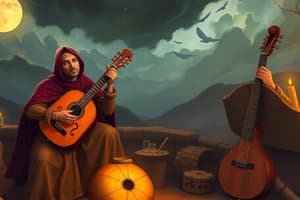Podcast
Questions and Answers
Die Geige ist ein Streichinstrument mit sechs Saiten.
Die Geige ist ein Streichinstrument mit sechs Saiten.
False (B)
Die Kora ist ein Musikinstrument aus Japan.
Die Kora ist ein Musikinstrument aus Japan.
False (B)
Das Klavier ist ein Blasinstrument.
Das Klavier ist ein Blasinstrument.
False (B)
Die Erhu ist ein zweisaitiges Instrument aus China, das mit einem Bogen gespielt wird.
Die Erhu ist ein zweisaitiges Instrument aus China, das mit einem Bogen gespielt wird.
Die Koto ist ein afrikanisches Instrument mit 21 Saiten.
Die Koto ist ein afrikanisches Instrument mit 21 Saiten.
Das Kendang ist ein einsaitiges Schlaginstrument aus China.
Das Kendang ist ein einsaitiges Schlaginstrument aus China.
Die ersten komplexen Musikinstrumente entstanden um 25.000 v. Chr.
Die ersten komplexen Musikinstrumente entstanden um 25.000 v. Chr.
Die Harfe ist ein gestrichenes Streichinstrument, das um 1000 v. Chr. in Griechenland entstanden ist.
Die Harfe ist ein gestrichenes Streichinstrument, das um 1000 v. Chr. in Griechenland entstanden ist.
Musikinstrumente dienen ausschließlich dazu, Melodie in der Musik zu erzeugen.
Musikinstrumente dienen ausschließlich dazu, Melodie in der Musik zu erzeugen.
Traditionelle Musikinstrumente haben keine Bedeutung für Kultur oder sozialen Status.
Traditionelle Musikinstrumente haben keine Bedeutung für Kultur oder sozialen Status.
Flashcards are hidden until you start studying
Study Notes
Exploring the World of Music: Musical Instruments
Music is an art form that has captivated hearts and minds for thousands of years. At its core, music is created through a diverse array of musical instruments. From the simple resonance of a child's voice to the deep bass rumble of a symphony orchestra, instruments have always been the vessels that carry our melodies, rhythms, and harmonies.
Varieties of Musical Instruments
Musical instruments can be broadly classified into two main categories: Western and Non-Western.
-
Western instruments: Developed in Europe and North America, these are commonly found in classical, pop, rock, and jazz music. Examples include:
- Piano: A keyboard instrument with hammers that strike strings.
- Guitar: A stringed instrument with six strings, played with fingers or a pick.
- Violin: A stringed instrument held under the chin and played with a bow.
- Flute: A woodwind instrument that produces sound by blowing air across a small hole.
-
Non-Western instruments: Diverse in origin, these are found in various cultures worldwide, such as those from Asia, Africa, and the Middle East. Examples include:
- Kora: A harp-lute instrument from West Africa, made from kina (gourd) and covered with cowhide.
- Koto: A 13-stringed instrument from Japan, made of wood and played with plectrums.
- Erhu: A two-stringed instrument from China, played with a bow and plucked with the left hand.
- Kendang: A double-headed drum from Indonesia, played by striking the heads with sticks.
Origins and Evolution
Musical instruments have a rich history, evolving alongside human development and cultural exchange. Archaeological evidence suggests that early humans used simple instruments like bones and stones to make sounds.
The first complex instruments emerged around 25,000 BCE, as ancient peoples developed new techniques for producing sound. Instruments like flutes, drums, and strings appeared in various cultures worldwide.
Early musicians experimented with new materials and designs, leading to a wide variety of instruments that we continue to use today. For example, the harp, which is a plucked string instrument, originated around 3000 BCE in ancient Egypt.
Instruments and their Purpose
Musical instruments serve multiple purposes in music. For instance, they can provide:
- Melody: Instruments like the violin or flute play melodies, which are sequences of pitches that create the main tune.
- Harmony: Instruments like the piano or guitar harmonize with the melody, providing chords that fill out the sound.
- Rhythm: Percussion instruments like drums or cymbals provide a steady beat, keeping the music in sync.
- Texture: Instruments like the harp or kora add depth and complexity to the music by playing chords and melodies together.
The Role of Musical Instruments in Society
Musical instruments are more than just tools for creating music. They are also symbols of culture, identity, and social status. For instance, the erhu, a traditional Chinese instrument, is associated with folk music and cultural heritage.
Musical instruments also play a role in education, contributing to cognitive development, fine motor skills, and musical literacy. Schools and music programs worldwide teach children about various instruments, exposing them to the richness and complexity of music.
The Future of Musical Instruments
Innovative musicians and engineers are constantly pushing the boundaries of what musical instruments can do. Electronic and digital instruments, such as synthesizers, drum machines, and virtual instruments, have revolutionized the way music is created. These instruments open up new possibilities for composition, sound design, and performance.
As technology continues to evolve, we can expect to see even more exciting developments in the world of musical instruments. Whatever the future holds, one thing is certain: music, and the instruments that create it, will continue to enrich our lives and shape our cultures for generations to come.
Studying That Suits You
Use AI to generate personalized quizzes and flashcards to suit your learning preferences.




